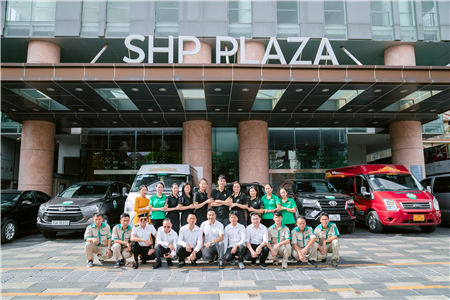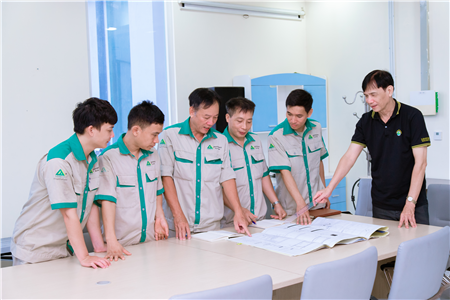MBA. Le Va Xi
Faculty of Marketing, National Economics University, Vietnam
Email: levaxi@yahoo.com
Full Word File: https://drive.google.com/file/d/1PJ81WTSdTcrzfMKYpJwqXSCiiuq60HRO/view?usp=sharing
Full PDF File: https://drive.google.com/file/d/1I1-Zb2ODooJ-0JQqRozbAy6YNUx_zNQM/view?usp=sharing
Proceedings of ICSEED 2021. (Full): https://drive.google.com/file/d/1V_WXpZzOLaHD0ImhXmjqxjzuAoUctPOG/view?usp=sharing
1. Introduction to research problem
Vietnam is a developing country, the process of urbanization is taking place rapidly, the dense population concentration has created a huge demand for housing in urban areas. The demand for housing has increased, the land fund has narrowed, leading to the development of high-rise apartment buildings as an inevitable trend in Vietnam’s urban areas. Housing businesses have been developing many multi-owner apartment buildings, including utilities to maximize human life. By 2020, 34.4% of the total population of Vietnam will live in urban areas. The population density in big cities like Hanoi is up to 9,343 people/km2. Preliminary statistics so far, the country has about 5,000 apartment buildings; in which concentrated mainly in Hanoi and Ho Chi Minh City. However, the process of residents moving into apartment buildings has generated many inadequacies, affecting residents’ confidence in the apartment living environment.
The satisfaction of residents living in high-rise apartment buildings is not just about their apartments. Satisfaction depends on the provision of services and utilities such as water supply, electricity, access roads, drainage systems, waste treatment facilities as well as attention to prompt repair and maintenance, etc. depends on the management and operation of the apartment building. The reality of apartment management in Vietnam over the past time has shown that there are still many shortcomings in the management and operation activities of apartment building management organizations. Organizations that manage and operate apartments also face the problem of increasing number of residents’ complaints and disputes as well as other dissatisfaction issues.
Therefore, measuring the satisfaction of residents in high-rise apartment buildings has received attention from housing policy makers and housing businesses. With the potential controversy often occurring around the management activities of apartment buildings, there have also been studies on people’s satisfaction focusing on the quality of housing services in general. However, to ensure the satisfaction of residents living in apartment buildings, it is necessary to pay attention to the quality of services that apartment management organizations provide in more detail. The evidence to date shows that there is a lack of in-depth studies on the apartment services provided by apartment management organizations and the satisfaction of residents with the services they receive.
The quality of apartment building operation management services is very important to maintain the operation of the building. That must be ensured through the commitment and efforts of the apartment management board in regularly reviewing the quality of building operation services, in order to bring satisfaction to residents. Therefore, the requirement to improve the provision of apartment building management services to support and maintain the general activities of the apartment complex becomes increasingly urgent. The reality of apartment building management poses an urgent need to study and assess the satisfaction of residents with the quality of apartment building operation management services in Vietnamese cities in order to improve management activities. apartment buildings, improving the quality of apartment services for residents.
2. Theoretical basis and research model
The satisfaction of people living in the apartment is the satisfaction of the place to live and the living environment in the apartment. Researchers agree that occupant satisfaction is a multidimensional concept that reflects residents’ aggregate assessment of the apartment living environment. The assessment of residents’ satisfaction with the elements of apartment building operation management services helps apartment management organizations understand the needs of residents and improve the quality of apartment operation management services. (Abolade et al., 2014). Therefore, measuring resident satisfaction with apartment operations management services plays an important role in improving the performance of apartment management (Abolade et al., 2014).
The available studies show that the quality of apartment building operation management services directly affect the satisfaction of residents. The service elements of apartment operation management include housing management policy, repair and maintenance, security, cleaning, landscaping and entertainment, management of utilities. These six groups of operational management service elements are the basic causes of residents’ satisfaction/dissatisfaction. Below is the relationship between these factors and the satisfaction of apartment residents.
Utilities management is an important component of apartment management, including all utilities serving the population, such as energy services, water supply, telecommunications, gas supply and use. These services are guaranteed by service companies based on contracts signed with residents. The apartment service management organization coordinates with other providers to ensure the functionality of utilities and interacts with residents to ensure that residents receive these services smoothly. Availability of basic services, such as electricity, water supply and drainage in an area that is well linked to other parts of the city, infrastructure, and guaranteed ownership are considered indicators. number of good quality accommodation (Ibem, 2011). Therefore, it is necessary to study the quality of management of utilities and it is necessary to identify this as an important variable affecting the satisfaction of residents.
Hypothesis H1: The quality of utility management has a positive impact on the satisfaction of residents for apartment building management and operation services.
Several existing studies have examined the impact of apartment management policy on resident satisfaction (Paris and Kangari, 2005; Gurstein and Small, 2005; James et al., 2009). Management policies are considered an important part of the apartment environment (Ahlbrandt and Brophy, 1976; Sadacca et al., 1974; Bechtel 1973;). Researchers have shown that resident satisfaction is positively correlated with apartment management’s certainty in enforcing the rules and management’s ability to respond to residents’ needs. These studies point to the direction of improving apartment operations management services as a way to increase resident satisfaction (Ahlbrandt and Brophy, 1976). After that, a large number of studies on housing management, which emphasized the importance of management policy for resident satisfaction (Ariff and Davies 2011; Pfrang 2015; Boyne and Walker 1999).
Hypothesis H2: The quality of housing management policy of the apartment building management board has a positive impact on the satisfaction of residents about apartment operation management services.
Apartment buildings also require adequate and effective repair and maintenance to avoid damage, affecting people’s health and life (Ishak et al., 2007). Building maintenance is defined as work “in addition to daily and regular cleaning, necessary to maintain the performance of the building structure and its services” (BSI 1986, cited in Wood 2009). Alternatively, Wood proposes a shorter definition for building maintenance as “the sum total of all the work that keeps the building running efficiently” (Wood 2009). Maintenance and repair play a role. management of apartments and residents’ satisfaction in Scotland (Croal et al., 2003) It is clear that maintenance is a factor that has a strong impact on overall apartment satisfaction. Therefore, it is necessary to study the factors related to maintenance contractors that affect the satisfaction of residents.
Hypothesis H3: Service quality of facilities management, repair and maintenance has a positive impact on residents’ satisfaction with apartment operation management services.
Security needs for people, and families or society is a natural and important need. Apartment buildings must always be safe and well protected. Security is one of the apartment building management services that has become important for any apartment complex. Apartment service management companies have found that in addition to their core business, non-core activities (such as cleaning and security) are part of their efforts to provide occupant satisfaction (Razali et al., 2007).
Hypothesis H4: Security service quality has a positive impact on residents’ satisfaction with apartment building operation management services.
Cleaning service is an essential service in apartment buildings. Cleaning the apartment environment is considered a core activity of housing service management organizations (Binder, 1992; Park, 1998). Cleaning is a key function of apartment building management organizations to ensure the health of residents. Today, clean facilities are very important to health care and occupant satisfaction, and it is also one of the most expensive services when operating a building (Klungseth and Blakstad, 2016; May and Pitt, 2012). Therefore, the standard of environmental cleanliness will have a direct impact on resident satisfaction.
Hypothesis H5: Cleaning quality has a positive impact on residents’ satisfaction with apartment operation management services.
Recreational activities and physical activity are indispensable requirements of the residential community in the apartment complex. There have been a number of studies on recreation and landscape sectors to assess their impact on resident satisfaction (Mahdavinejad et al., 2012; Lai and Yik (2011). Landscape and recreation is one of the main areas of apartment operation management services. Lai (2012) identified a number of factors related to landscaping and recreation, including aesthetics and tidiness of crops, pest control, environmental protection measures, recreational facilities (e.g. play equipment), and recreational facilities.
Hypothesis H6: Landscape and entertainment have a positive impact on residents’ satisfaction with apartment building operation management services.
Combining the independent and dependent variables, we have a research model as follows

3. Research methodology
In order to carry out the research objective of assessing the impact of apartment operation management service factors on the satisfaction of residents, the research process has been conducted through two phases, including qualitative and quantitative research. In phase 1, conducting qualitative research by directly interviewing a sample of 15 residents living in the apartment and 6 apartment managers to determine the components measuring 6 independent variables and dependent variable. The author used a semi-structured questionnaire to collect information for the identification of observed variables measuring factors in the research model to design the questionnaire. The Likert scale from 1 to 5 points (1: strongly disagree – 5: strongly agree) was also applied to measure observed variables.
Table 1: Observed variables measuring the independent variable
|
Independent variable |
Observed variable |
Code |
|
Utility management |
Clean and odorless drinking water |
TI1 |
|
Fresh air and proper airflow |
TI2 |
|
|
Elevator and clear instructions system |
TI3 |
|
|
Good soundproofing system, no noise |
TI4 |
|
|
I can easily use gadgets when I need it |
TI5 |
|
|
Diverse utilities are provided 24/24 and are fixed immediately when there is a problem |
TI6 |
|
|
Management policy |
Building service charges are completely reasonable |
CS1 |
|
The notices of the building management are always transparent, clear and easy to understand |
CS2 |
|
|
The process of handling dispute and resolving complaints is specific, scientific, and fast |
CS3 |
|
|
The building management board always resolves disputes and complaints in a fair, civilized and reasonable manner |
CS4 |
|
|
Knowledgeable, courteous and attentive building management employees |
CS5 |
|
|
Repair and maintenance |
I see the building is under regular maintenance |
SC1 |
|
I found the maintenance and repair process to be very quick |
SC2 |
|
|
After maintenance and repair, the utilities work very well again |
SC3 |
|
|
I find the repair and maintenance employees friendly and polite |
SC4 |
|
|
I found the building maintenance employees to have good skills |
SC5 |
|
|
Cleaning |
I found the common areas to be very clean |
VS1 |
|
The cleaning employees completes the entire job |
VS2 |
|
|
The cleaning employees is polite, considerate and attentive. |
VS3 |
|
|
Landscape and entertainment |
Green space is suitable |
CQ1 |
|
Fresh and pleasant air |
CQ2 |
|
|
I find it easy to move to different locations or move around in the apartment complex |
CQ3 |
|
|
The entertainment areas in the apartment are very diverse |
CQ4 |
|
|
The entertainment areas have modern facilities and serve my needs well |
CQ5 |
|
|
Security |
All areas in the apartment such as elevators, foyers, basements for parking, etc., all have strict security systems and surveillance cameras |
AN1 |
|
Polite and friendly security employees |
AN2 |
|
|
Security employees are well trained |
AN3 |
Source: Collected by Author
Table 2: Observable variables measuring the dependent variable
|
Dependent variable |
Code |
|
Based on my apartment experience, I’m very satisfied |
HL1 |
|
The apartment provides operational management services beyond my expectations |
HL2 |
|
I am very happy to live in this apartment |
HL3 |
|
I feel the decision to live in this apartment is very right |
HL4 |
Source: Collected by Author
In phase 2, direct quantitative survey of residents living in apartment buildings. The survey sample size is 255 residents living in some typical apartment buildings in two cities, Hanoi and Hai Phong such as Time City, HH Linh Dam, Golden Tower in Hanoi and SHP Plaza, Bac Son, Vincity in Hai Phong. Data were analyzed by SPSS software including descriptive statistics and multiple regression equations to test the research hypotheses.
Table 3: Demographic characteristics of the study sample
|
Personal characteristics |
Respondents |
Quantity |
Rate (%) |
|
Time living in apartment |
Less than 1 year |
64 |
25.1 |
|
1-2 years |
99 |
38.8 |
|
|
3-5 years |
55 |
21.6 |
|
|
6-8 years |
24 |
9.4 |
|
|
9-10 years |
7 |
2.7 |
|
|
From 11 years or more |
6 |
2.4 |
|
|
Academic level |
Below high school |
4 |
1.6 |
|
High school |
11 |
4.3 |
|
|
College |
34 |
13.3 |
|
|
University |
182 |
71.4 |
|
|
Postgraduate |
16 |
6.3 |
|
|
Doctor |
8 |
3.1 |
|
|
Income |
Under 5 million |
41 |
16.1 |
|
6-10 million |
34 |
13.3 |
|
|
11-15 million |
39 |
15.3 |
|
|
16-20 million |
57 |
22.4 |
|
|
21-30 million |
23 |
9.0 |
|
|
Over 30 million |
61 |
23.9 |
4. Research results and discussion
4.1 Testing model and research hypotheses
4.1.1 Analysis of the reliability of the scales
The scales are evaluated through reliability testing using Cronbach's Alpha coefficient and calculating the total variable correlation coefficient. Then the retained variables will continue to be analyzed using the exploratory factor analysis (EFA) tool. Use Cronbach's Alpha reliability coefficient method before analyzing EFA factors to eliminate nonconforming criteria because these nonconforming criteria (junk) can create spurious factors (Nguyen Dinh Tho, Nguyen). Thi Mai Trang, 2009). The Cronbach Alpha reliability coefficient only indicates whether the criteria are related or not, but does not indicate which criteria should be removed and which observed variables should be kept. Then, the calculation of the correlation coefficient between the total variable will help to exclude those criteria that do not contribute much to the description of the concept to be measured (Hoang Trong, Chu Nguyen Mong Ngoc, 2008).
The minimum condition to test the reliability of the scale using Cronbach's Alpha coefficient is that each factor in the research model must have at least 2 observed variables. All 9 variables in my research model meet this requirement.
Table 4 Cronbach’s Alpha coefficient of each variable
|
Variable |
No. of observed variables |
Cronbach's Alpha coefficient |
|
Complaint |
7 |
0,924 |
|
Time for problem solving |
3 |
0,781 |
|
Utility management |
6 |
0,825 |
|
Management policy |
5 |
0,852 |
|
Repair and maintenance |
5 |
0,880 |
|
Cleaning |
3 |
0,901 |
|
Landscape |
5 |
0,866 |
|
Security |
3 |
0,889 |
|
Overall satisfaction |
4 |
0,912 |
According to (Nunnally, J., 1978), all the observed variables have the total correlation coefficient (Corrected Item - Total Correlation) >= 0.3, then the variable meets the requirements. In addition, the value of Cronbach’s Alpha coefficient ensures the standard from 0.6 or more (Hoang Trong, Chu Nguyen Mong Ngoc, 2008). In addition, for the highest reliability, the value of Cronbach’s Alpha coefficient when removing the variable needs to be smaller than the total Cronbach’s Alpha coefficient. The results show that all 9 factors give Cronbach’s Alpha coefficient > 0.6. At the same time, the observed variables of each scale have a total correlation coefficient >= 0.3, showing that all observed variables meet the standards (Nunnally, J., 1978).
Table 5 Cronbach’s Alpha coefficient of each variable after adjustment
|
Variable |
No. of observed variables |
Cronbach's Alpha coefficient |
|
Complaint |
7 |
0,924 |
|
Time for problem solving |
2 |
0,852 |
|
Utility management |
6 |
0,825 |
|
Management policy |
5 |
0,852 |
|
Repair and maintenance |
5 |
0,880 |
|
Cleaning |
3 |
0,901 |
|
Landscape |
5 |
0,866 |
|
Security |
3 |
0,889 |
|
Overall satisfaction |
3 |
0,914 |
Factor analysis
Exploratory factor analysis (EFA) for independent variables
After verifying the reliability of the scale, the factors affecting the satisfaction of residents in the operation and management services of the apartment building are considered factors of utility quality, management policy, repair and maintenance, landscaping and recreation, cleaning, security as original. The author continues to perform exploratory factor analysis with the remaining 27 variables on SPSS software.
According to (Kaiser, H.F., 1974), to meet the requirement that EFA can be performed, the KMO > 0.5. The KMO value in this case is 0.861 > 0.5, which shows that the data is suitable for factor analysis, and Sig. Bartlett’s Test = 0.000 < 0.05, which states that the observed variables are correlated in the population. In addition, According to Hair et al. (1998, 111), factor loading is an indicator to ensure the practical significance of EFA. With a sample number of 255, the load factor is greater than 0.35, the EFA is sufficiently meaningful. So with the above variables I am qualified to do EFA.
After conducting EFA analysis with the above 36 observed variables, I found that the observed variables all belong to the groups suitable for the Rotated Component Matrix as follows:
Table 6: Rotated Component Matrix of Independent Variables
|
|
Component |
|||||||
|
1 |
2 |
3 |
4 |
5 |
6 |
7 |
8 |
|
|
SC4 |
0,792 |
|
|
|
|
|
|
|
|
VS2 |
0,775 |
|
|
|
|
|
|
|
|
VS3 |
0,765 |
|
|
|
|
|
|
|
|
SC3 |
0,730 |
|
|
|
|
|
|
|
|
VS1 |
0,713 |
|
|
|
|
|
|
|
|
SC5 |
0,694 |
|
|
|
|
|
|
|
|
SC1 |
0,650 |
|
|
|
|
|
|
|
|
SC2 |
0,591 |
|
|
|
|
|
|
|
|
TI3 |
0,531 |
|
|
|
|
|
|
|
|
CS5 |
0,497 |
|
|
|
|
|
|
|
|
KN2 |
|
0,840 |
|
|
|
|
|
|
|
KN4 |
|
0,829 |
|
|
|
|
|
|
|
KN1 |
|
0,825 |
|
|
|
|
|
|
|
KN6 |
|
0,819 |
|
|
|
|
|
|
|
KN3 |
|
0,808 |
|
|
|
|
|
|
|
KN7 |
|
0,799 |
|
|
|
|
|
|
|
KN5 |
|
0,760 |
|
|
|
|
|
|
|
CQ4 |
|
|
0,831 |
|
|
|
|
|
|
CQ5 |
|
|
0,740 |
|
|
|
|
|
|
CQ1 |
|
|
0,568 |
|
|
|
|
|
|
CQ2 |
|
|
0,556 |
|
|
|
|
|
|
CS1 |
|
|
|
0,691 |
|
|
|
|
|
CS4 |
|
|
|
0,585 |
|
|
|
|
|
CS3 |
|
|
|
0,582 |
|
|
|
|
|
CQ3 |
|
|
|
0,492 |
|
|
|
|
|
TI6 |
|
|
|
|
0,794 |
|
|
|
|
TI5 |
|
|
|
|
0,557 |
|
|
|
|
TI4 |
|
|
|
|
0,477 |
|
|
|
|
AN3 |
|
|
|
|
|
0,682 |
|
|
|
AN2 |
|
|
|
|
|
0,640 |
|
|
|
AN1 |
|
|
|
|
|
0,553 |
|
|
|
CS2 |
|
|
|
|
|
0,533 |
|
|
|
TG2 |
|
|
|
|
|
|
0,887 |
|
|
TG1 |
|
|
|
|
|
|
0,825 |
|
|
TI1 |
|
|
|
|
|
|
|
0,749 |
|
TI2 |
|
|
|
|
|
|
|
0,700 |
Source: Collected by Author
According to (Hair, 1998) factor loading >= 0.35 to ensure the practicality of EFA. I found that all 36 observed variables satisfy this condition. Finally, the author obtained the extracted variance = 75,560% and the Eigenvalues index is 1,115, ensuring that the results of the analysis of exploratory factors are only accepted when the extracted variance is > 50% and Eigenvalues > 1. Thus, the independent variable including observed variables belonging to 6 groups of factors explains 75.560% of the dependent variable.
Exploratory factor analysis EFA for the dependent variable
Based on theories and related models in the above chapter, the dependent variable in the topic is defined as “Resident satisfaction” which is evaluated based on 4 observed variables. I conducted exploratory factor analysis EFA for the dependent variable on SPSS software. The results of the KMO and Barlett’s test for the dependent variable show that the KMO value in this case reaches 0.746 > 0.5, which shows that the data is suitable for factor analysis and the Barlett’s Sig = 0.000 < 0.05 says that the observed variables are correlated with each other. So I am qualified to do EFA for the dependent variable. The results of performing EFA show that all observed variables converge at 1 factor. At the same time, the extracted variance = 85.651% > 50% and the Eigenvalues index = 2,570 >1 ensure that the factor analysis results are accepted. Thus, the dependent variable consists of 3 observed variables belonging to 1 factor, which explains 85,651% of the variables.
|
Component |
Initial Eigenvalues |
Extraction Sums of Squared Loadings |
||||
|
|
Total |
% of Variance |
Cumulative % |
Total |
% of Variance |
Cumulative % |
|
1 |
2.570 |
85.651 |
85.651 |
2.570 |
85.651 |
85.651 |
|
2 |
268 |
8.934 |
94.585 |
|
|
|
|
3 |
162 |
5.415 |
100.000 |
|
|
|
4.2.3 Regression model and conclusions about research hypotheses
The model’s adjusted R2 squared value of 0.657 shows that 65.7% of the variation in the variable “Resident satisfaction” is explained by the variation of 6 independent variables (“Repair and maintenance”, “Security”, “Utility management quality”, “Landscape and entertainment”, “Cleaning”, “Building management policy”). Durbin – Watson value = 1,845 ≈ 2 shows that there is no first order series correlation in the model and the collected data is good.
Next, testing the hypothesis about the overall fit of the model shows that the F-test value in the ANOVA table is equal to 82,162 and the Sig value of the test F = 0.000 < 0.05, shows that the R squared of the population is not 0. That means that the linear regression model built is suitable for the population.
Table 11: Regression analysis
|
Model |
Unstandardized coefficient |
Standardized coefficient |
t |
Sig. |
||
|
B |
Standard Deviation |
Beta |
|
|||
|
1 |
(Constant) |
-0.362 |
0.199 |
|
-1.818 |
0.070 |
|
Utility management quality (QLTI) |
0.098 |
0.045 |
0.105 |
2.199 |
0.029 |
|
|
Repair and maintenance (SCBT) |
0.176 |
0.076 |
0.149 |
2.324 |
0.021 |
|
|
Management policy (CSQL) |
0.168 |
0.068 |
0.142 |
2.481 |
0.014 |
|
|
Security (AN) |
0.181 |
0.062 |
0.179 |
2.926 |
0.004 |
|
|
Landscape and entertainment (CQGT) |
0.352 |
0.055 |
0.354 |
6.346 |
0.000 |
|
|
Cleaning (VS) |
0.084 |
0.040 |
0.087 |
2.087 |
0.038 |
|
Source: Collected by Author
The result shows the Sig value of all factors are less than 0.05, so the control variables are significant for the dependent variable and no variable is removed.
We have the regression equation:
HL = 0.105*CLTI + 0,149*VSSC + 0,142*CSQL + 0,179*AN + 0,354*CQGT + 0,087*VS
The equation helps to determine the degree of influence of the factors, thereby assessing the influence of each factor in the model on the dependent variable, which is the level of satisfaction of residents with apartment operation management services.
The results of assessing the influence of factors on the dependent variable are as follows: “Landscape and entertainment” has the greatest impact with an impact level of 0.354; followed by the factor “Security” with an impact level of 0.179; “Repair and maintenance” with an impact level of 0.149; “Management policy” with an impact level of 0.142. The two factors with the least impact are “Utility management quality” and “Cleaning” with levels of 0.105 and 0.087, respectively.
Table 12: Conclusions about research hypotheses
|
Hypothesis |
Content |
Conclusion |
|
GT1 |
Good quality of utility management increases resident satisfaction |
Approved |
|
GT2 |
Good management policy increases resident satisfaction |
Approved |
|
GT3 |
Good maintenance and repair increases resident satisfaction |
Approved |
|
GT4 |
Good cleaning increases residents’ satisfaction about apartment management and operation services |
Approved |
|
GT5 |
The more the entertainment and landscape ensures, the more satisfied residents will be |
Approved |
|
GT6 |
Good security increases residents’ satisfaction about apartment operation and management services |
Approved |
5. Conclusion and policy implications
This study examines the relationship between residents' satisfaction about the quality of apartment building operation management services with related factors including quality of utilities, security, cleaning, repair and maintenance, etc. The basic research hypotheses are given at the beginning with a positive relationship between the factors and proven in the above research results.
Through the research process, there are 6 factors that explain up to 65.7% of residents' satisfaction about apartment operation and management services, including “Repair and maintenance”, “Security”, “Utility management quality”, “Landscape and entertainment”, ““ Cleaning”, “Building management policy”. All factors have a positive correlation with “Resident satisfaction”. In particular, the factor “Entertainment and landscape” has the greatest influence on people’s satisfaction about apartment operation and management services. Then followed by are “Security”, “Repair and maintenance”, Management policy”, “Quality of utility management” and finally “Cleaning”.
Good “repair and maintenance” can increase residents’ satisfaction with apartment operation management services. However, residents have not yet appreciated this factor because most of the apartments are newly built, so this problem is not serious but the building management does good repair and maintenance. This result is different from some studies in developing countries that show that this is the most important factor determining the life cycle of an apartment building.
The “landscape and entertainment” with the biggest influence can be understood that the living space in the apartment is highly valued by residents. The greener and more natural the living space around the apartment is, the more diverse the entertainment facilities are, the more it will satisfy the needs of residents. For some families with young children, such as green parks, swimming pools or children's play areas are absolutely necessary. In fact, in Hanoi and Hai Phong due to limited land fund, there are too few apartment buildings with landscape and entertainments to meet the requirements of residents.
In fact, the response and handling of complaints from residents of the apartment building management board is still slow, there are more than four complaints about the same problem. This can come from a complex service delivery process. In fact, the complaint handling process has many steps, which wastes time and creates difficulties when residents do it.
Overall satisfaction in terms of trust, understanding and service support should also be improved and promoted. The negative feedbacks of residents may come from the attitude, working style and qualifications of the building management employees.
The quality of utility management of the apartments has not really satisfied residents with an average score of 3.52/5. The cause may come from the long time of using and putting the utility into operation, the apartment has not been replaced and repaired and maintained regularly; or there is maintenance but the results after maintenance are not good, making residents unhappy.
5.2 Policy implications for Apartment Management Board
Based on the research results, the author proposes a number of solutions for organizations providing apartment building operation management services, as well as for other stakeholders such as local authorities and apartment maintenance contractor.
Firstly, there should be a quick, reasonable, convenient and timely complaint handling process for residents. Based on the actual situation, the management of many apartments does not have a transparent and clear handling process for residents, causing frustration and reducing the satisfaction of residents living in the apartment. The time to handle urgent issues needs to be shortened by having a timely support unit right at the apartment building or members of the Management Board need to have high expertise and quick judgment to respond and handle any situations. In addition, taking advantage of technology, the Apartment Management Board should invest in equipment to monitor, anticipate and promptly support residents via hotline, website, fanpage, .. Based on these technological platforms, residents can directly contact the building managers when there is a problem and get immediate answers.
Second, the construction of a safe and healthy living space should be promoted for all residents living in the apartment. A safe, healthy living space includes quality entertainment landscape, cleaning service and a strict level of security. The management unit needs to actively renew entertainment facilities, aiming for diversity and high quality services to satisfy the needs of residents. In addition, the trend of green living is increasingly popular. The management needs to actively create a living space around the apartment building with a green park for residents to relax on holidays or in their free time. For security, improve the professionalism of the security system, assign guarding areas, reasonably protect, and ensure the security of residents’ assets. For example, access to buildings requires resident cards (the number of cards is issued per household), the parking basement needs to be zoned for different vehicles, and staffs need to be on duty 24/24. In terms of hygiene, quality of cleaning services should be improved to ensure ventilation and proper airflow; common spaces and sewers should always be clean.
Third, focus on providing and optimizing utilities at the apartment, focusing on personalization and ease of use. The quality of essential utilities is one of the influential factors for residents' satisfaction with apartment management and operation services. With a diverse system of utilities, in order to maximize customer experience and increase satisfaction, the Management Board needs to regularly add, renew, repair and maintain them to ensure facilities quality. The facilities here include elevators, soundproofing systems, fire extinguishers, and etc. Residents need to be trained in the safe and proper use of utilities to be able to access and use them promptly when needed.
Fourth, regular monitoring and inspection should be focused. Inspection stage includes during, before and after service provision. This helps the management board to monitor and timely calculate possible problems, thereby having a timely plan to support residents, reducing complaints and unwanted dissatisfaction from residents. The inspection unit can carry out inspections in irregular or periodic occasions and with a person in charge, drawing repair experience after the inspection.
Fifth, human resources should be improved. The unit can implement human resource development activities by recruiting, training, and motivating employees. Businesses should establish a process and plan for employee management. Employees here include maintenance and repair staffs, cleaning staff, security staff, resident support staff such as the front desk department, etc. When employees are well trained and a comfortable working conditions, they will have a better working spirit and complete the assigned tasks with higher quality. In addition, it is necessary to consider correcting the current staff in terms of attitudes and ways of working with residents to increase professionalism and courtesy. Recruiting a new human resource team needs to be evaluated based on educational qualifications and practical experience as well as soft skills because apartment operation and management services require high customer contact.
References
- Adriaanse, C.C.M., 2007. Measuring Residential Satisfaction: A Residential Environmental Satisfaction Scale (RESS). Journal of Housing and the Built Environment, 22(3), pp.287– 304.
- Ariff, N.R.M. & Davies, H., 2011. Multi‐owner low‐cost housing management in Malaysia. International Journal of Housing Markets and Analysis, 4(3), pp.268–289.
- Antwi, S.K. & Hamza, K., 2015. Qualitative and Quantitative Research Paradigms in Business Research: A Philosophical Reflection. European Journal of Business and Management, 7(3), pp.217–225.
- Creswell, J.W., 2014. Research Design Qualitative, Quantitative and Mixed Methods Approaches 4th ed., California: Sage Publications, USA.
- Dekker, K., de Vos, S., Musterd, S., & van Kempen, R., 2011. Residential Satisfaction in Housing Estates in European Cities: A Multi-level Research Approach. Housing Studies, 26 (4), pp.479–499.
- Elsinga, M. & Hoekstra, J., 2005. Homeownership and Housing Satisfaction. Journal of Housing and the Built Environment, 20(4), pp.401–424.
- Fatoye, E.O. & Odusami, K.T., 2009. Occupants’ Satisfaction Approach to Housing Performance Evaluation: The Case of Nigeria. In RICS COBRA research conference held at the University of Cape Town.
- Fong, K.L., 2010. A study of the causes of conflicts in the tenants purchase scheme in Hong Kong. University of Hong Kong.
- Koebel, C.T. and Etuk, E., 1998. Improving Management of Assisted Housing Through Tenant Feedback. Virginia Center for Housing Research.
- Lai, A.W.Y. & Lai, W.M., 2013. Users’ Satisfaction Survey on Building Maintenance in Public Housing. Engineering, Construction and Architectural Management, 20(4), pp.420–440.
- Lai, J.H.K., 2011. Comparative Evaluation of Facility Management Services for Housing Estates. Habitat International, 35(2), pp.391–397.
- Lai, J.H.K., 2013. Gap theory based analysis of user expectation and satisfaction : The case of a hostel building. Building and Environment, 69, pp.183–193.
- Lai, J.H.K., 2010. Investigating the Quality of FM Services in Residential Buildings. In Proceedings of W070- Special Track,18th CIB World Building Congress, Salford, UK. pp. 13–25.
- Lai, J.H.K. & Man, C.S., 2017. Developing a Performance Evaluation Scheme for Engineering Facilities in Commercial Buildings: State-of-the-Art Review. International Journal of Strategic Property Management, 21(1), pp.41–57.
- Báo cáo thị trường nhà chung cư của Bộ xây dựng, 2019.
- Trương Tuấn Anh, Trần Hoài Nam và Phạm Hương Giang (2014). Ảnh hưởng của chất lượng dịch vụ quản lý chung cư tới sự hài lòng của người dân sống trong chung cư: Nghiên cứu thực nghiệm trên địa bàn Hà Nội. Tạp chí Kinh tế & Phát triển. số 205 (II), tr. 97-107.
- Hoàng Trọng, Chu Nguyễn Mộng Ngọc. (2008). Phân tích dữ liệu nghiên cứu với SPSS.


















